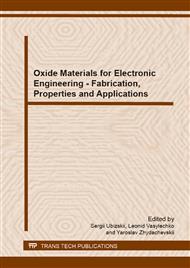[1]
K.G. Belabaev, V.B. Markov, S.G. Odoulov, Photovoltaic effect in reduced crystals of lithium niobate, Ukr. J. Phys. 24 (1979) 366-371.
Google Scholar
[2]
P.F. Bordui, D.H. Jundt, E.M. Standifer, R.G. Norwood, R.L. Sawin, J.D. Galipeau, Chemically reduced lithium niobate single crystals: processing, properties and improved surface acoustic wave device fabrication and performance, J. Appl. Phys. 85 (1999) 3766-3769.
DOI: 10.1063/1.369775
Google Scholar
[3]
B.K. Brickeen, C. Shanta, Reducing the pyroelectric effect in lithium niobates Q-switch crystals, Opt. Eng. 49 (2010) 124201.
DOI: 10.1117/1.3520053
Google Scholar
[4]
D.Yu. Sugak, I.M. Solskii, I.I. Syvorotka, M.M. Vakiv, Influence of thermochemical treatment on the optical properties of the lithium niobate single crystals, New Technologies 1 (2012) 3-12.
Google Scholar
[5]
T.R. Volk, M. Wöhlecke. Lithium niobate. Defects, photorefraction and ferroelectric switching, Springer-Verlag, Berlin, Heidelberg, 2008.
DOI: 10.1007/978-3-540-70766-0
Google Scholar
[6]
A. Dhar, A. Mansingh, Optical properties of reduced lithium niobate single crystals, J. Appl. Phys. 68 (1990) 5804-5809.
DOI: 10.1063/1.346951
Google Scholar
[7]
S. Bredikhin, S. Scharner, M. Klingler, V. Kveder, B. Red'kin, W. Weppner, Nonstoichiometry and electrocoloration due to injection of Li+ and O2- ions into lithium niobate, J. Appl. Phys. 88 (2000) 5687-5694.
DOI: 10.1063/1.1318367
Google Scholar
[8]
A.V. Yatsenko, S.V. Yevdokimov, A.S. Pritulenko, D.Yu. Sugak, I.M. Solskii, Electrical properties of LiNbO3 crystals reduced in a hydrogen atmosphere, Physics of the Solid State 54 (2012) 2231-2235.
DOI: 10.1134/s1063783412110339
Google Scholar
[9]
I.M. Solskii, D.Yu. Sugak, V.M. Gaba, The obtaining of optical grade and large dimensions lithium niobate single crystals, Tekhnologiya i Konstruirovanie v Elektronnoj Apparature 5 (2005) 51-54.
Google Scholar
[10]
A. Mansingh, A. Dhar, The ac conductivity and dielectric constant of lithium niobate single crystals, J. Phys. D: Appl. Phys.18 (1985) 2059-2071.
DOI: 10.1088/0022-3727/18/10/016
Google Scholar
[11]
J. Liu, E. Kharitonova, C. Duan, W. Mei, R. Smith, J. Hardy, Phase transition in single crystal Cs2Nb4O11, J. Chem. Phys. 123 (2005) 144503.
DOI: 10.1063/1.1883143
Google Scholar
[12]
M.A.L. Nobre, S. Lanfredi, Dielectric loss and phase transition of sodium potassium niobates ceramic investigated by impedance spectroscopy, Catalysis Today 78 (2003) 529-538.
DOI: 10.1016/s0920-5861(02)00349-8
Google Scholar
[13]
O.F. Shirmer M. Imlau., C.Merschjann, B. Schoke, Electron small polarons and bipolarons in LiNbO3, J. Phys.: Condens. Matter 21 (2009) 123201.
DOI: 10.1088/0953-8984/21/12/123201
Google Scholar
[14]
D. Sugak, Ya. Zhydachevskii, Yu. Sugak, O. Buryy, S. Ubizskii, I. Solskii, M. Schrader, K.-D. Becker, In-situ investigation of optical absorption changes in LiNbO3 during reducing/oxidizing high-temperature treatments, J. Phys.: Cond. Matter 19 (2007) 086211.
DOI: 10.1088/0953-8984/19/8/086211
Google Scholar


